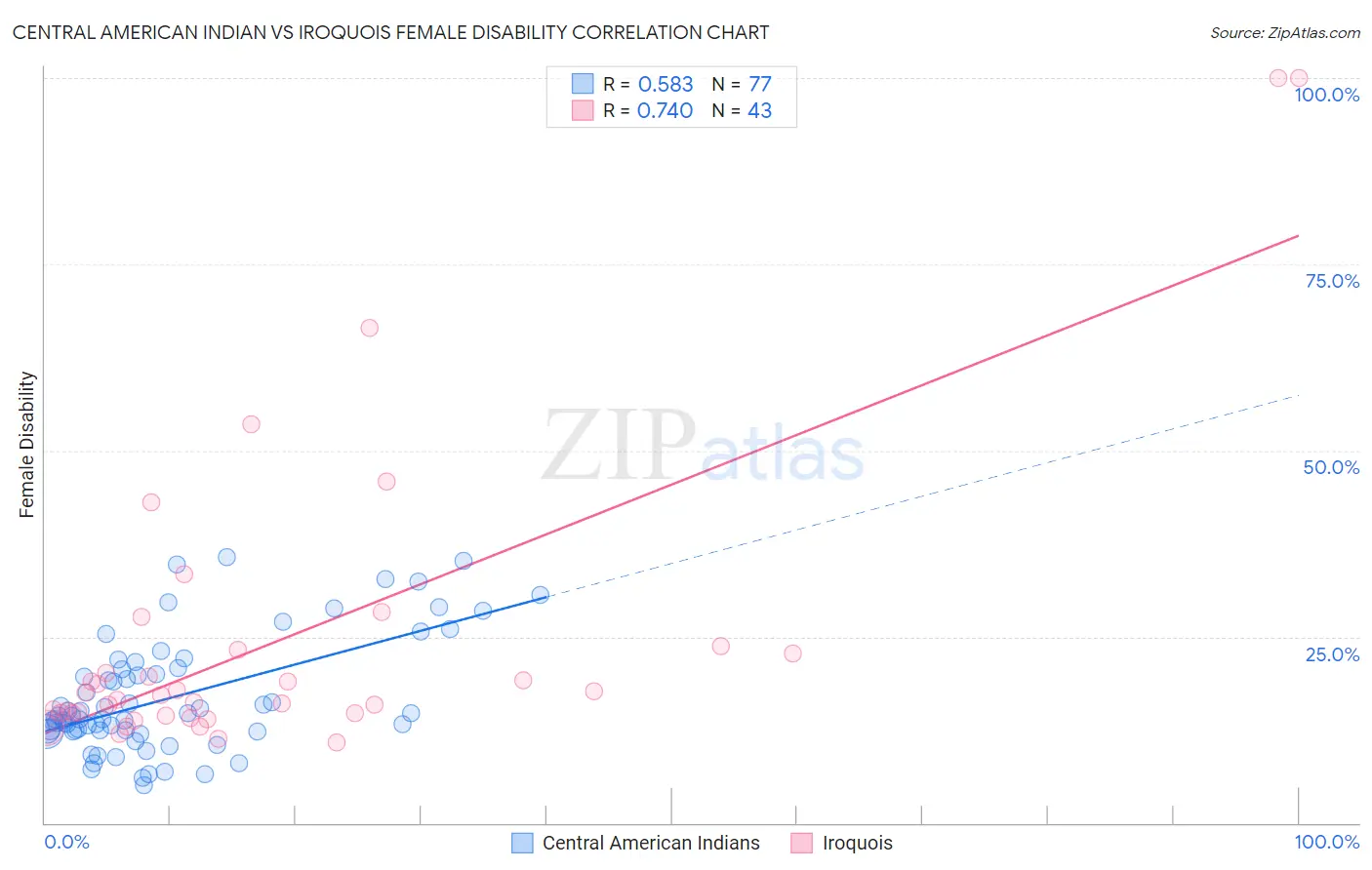Central American Indian vs Iroquois Female Disability
COMPARE
Central American Indian
Iroquois
Female Disability
Female Disability Comparison
Central American Indians
Iroquois
13.6%
FEMALE DISABILITY
0.0/ 100
METRIC RATING
307th/ 347
METRIC RANK
14.0%
FEMALE DISABILITY
0.0/ 100
METRIC RATING
319th/ 347
METRIC RANK
Central American Indian vs Iroquois Female Disability Correlation Chart
The statistical analysis conducted on geographies consisting of 326,112,462 people shows a substantial positive correlation between the proportion of Central American Indians and percentage of females with a disability in the United States with a correlation coefficient (R) of 0.583 and weighted average of 13.6%. Similarly, the statistical analysis conducted on geographies consisting of 207,273,791 people shows a strong positive correlation between the proportion of Iroquois and percentage of females with a disability in the United States with a correlation coefficient (R) of 0.740 and weighted average of 14.0%, a difference of 3.1%.

Female Disability Correlation Summary
| Measurement | Central American Indian | Iroquois |
| Minimum | 5.1% | 10.9% |
| Maximum | 35.6% | 100.0% |
| Range | 30.5% | 89.1% |
| Mean | 16.8% | 24.5% |
| Median | 14.4% | 17.2% |
| Interquartile 25% (IQ1) | 12.3% | 14.7% |
| Interquartile 75% (IQ3) | 20.7% | 23.2% |
| Interquartile Range (IQR) | 8.3% | 8.6% |
| Standard Deviation (Sample) | 7.6% | 20.4% |
| Standard Deviation (Population) | 7.5% | 20.2% |
Demographics Similar to Central American Indians and Iroquois by Female Disability
In terms of female disability, the demographic groups most similar to Central American Indians are French Canadian (13.6%, a difference of 0.29%), Cree (13.7%, a difference of 0.46%), French American Indian (13.7%, a difference of 0.52%), Apache (13.7%, a difference of 0.63%), and Dominican (13.5%, a difference of 0.92%). Similarly, the demographic groups most similar to Iroquois are Paiute (14.0%, a difference of 0.29%), American (14.1%, a difference of 0.34%), Chippewa (14.0%, a difference of 0.40%), Potawatomi (14.1%, a difference of 0.48%), and Pueblo (14.1%, a difference of 0.49%).
| Demographics | Rating | Rank | Female Disability |
| Immigrants | Portugal | 0.0 /100 | #303 | Tragic 13.5% |
| Immigrants | Micronesia | 0.0 /100 | #304 | Tragic 13.5% |
| Dominicans | 0.0 /100 | #305 | Tragic 13.5% |
| French Canadians | 0.0 /100 | #306 | Tragic 13.6% |
| Central American Indians | 0.0 /100 | #307 | Tragic 13.6% |
| Cree | 0.0 /100 | #308 | Tragic 13.7% |
| French American Indians | 0.0 /100 | #309 | Tragic 13.7% |
| Apache | 0.0 /100 | #310 | Tragic 13.7% |
| Hopi | 0.0 /100 | #311 | Tragic 13.7% |
| Delaware | 0.0 /100 | #312 | Tragic 13.8% |
| Blackfeet | 0.0 /100 | #313 | Tragic 13.8% |
| Puget Sound Salish | 0.0 /100 | #314 | Tragic 13.8% |
| Alaskan Athabascans | 0.0 /100 | #315 | Tragic 13.9% |
| Spanish Americans | 0.0 /100 | #316 | Tragic 14.0% |
| Chippewa | 0.0 /100 | #317 | Tragic 14.0% |
| Paiute | 0.0 /100 | #318 | Tragic 14.0% |
| Iroquois | 0.0 /100 | #319 | Tragic 14.0% |
| Americans | 0.0 /100 | #320 | Tragic 14.1% |
| Potawatomi | 0.0 /100 | #321 | Tragic 14.1% |
| Pueblo | 0.0 /100 | #322 | Tragic 14.1% |
| Blacks/African Americans | 0.0 /100 | #323 | Tragic 14.1% |